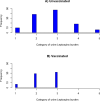Urine shedding patterns of pathogenic Leptospira spp. in dairy cows
- PMID: 37525220
- PMCID: PMC10391894
- DOI: 10.1186/s13567-023-01190-w
Urine shedding patterns of pathogenic Leptospira spp. in dairy cows
Abstract
Pathogenic Leptospira spp. are zoonotic bacteria that infect wild and domestic animals. Humans contract leptospirosis directly through contact with infected animals or indirectly from contaminated water or soil. In mammalian reservoirs, the pathogen can colonize renal tubules for lengthy periods and persistently contaminate the environment through urine. Cattle have been reported to shed several serovars; with Hardjo the most common serovar found in cattle. Without clinical manifestations, the infection can spread within a herd, impairing productivity, and putting workers like farmers, abattoir operators and veterinarians at risk. The dynamics of pathogenic Leptospira shedding was studied in six dairy herds in southern Chile. Various intermittent urine shedding patterns were found, with elimination periods between 79 and 259 days and bacterial loads ranging from 3 × 104 to 4.4 × 104 bacteria/mL. The current study was the first to assess the various urine shedding patterns and loads of pathogenic leptospires shed through urine of naturally-infected dairy cows. In addition, the study suggests that vaccination does not prevent cattle infection, although it influences loads of pathogenic leptospires excreted in urine. Our study provides a great awareness of asymptomatic animal carriers in an endemic area and will contribute to improving disease control and designing better prevention strategies.
Keywords: Leptospirosis; cattle; dairy cows; transmission; urine shedding.
© 2023. The Author(s).
Conflict of interest statement
The authors declare that they have no competing interests.
Figures



References
-
- Ellis WA. Animal Leptospirosis. In: Adler B, editor. Leptospira and Leptospirosis. Berlin, Heidelberg: Springer; 2015. pp. 99–137.
MeSH terms
Grants and funding
LinkOut - more resources
Full Text Sources
Miscellaneous

